Index
- E. coli - Indicator Baterium of Choice
- Water Sampling by Boat
- The Importance of Proper Shellfish Tags
- Walkover Surveys - A Qualitative Overview of Shellfish
- Shout Out to Vounteers
Escherichia coli - DMR's Indicator Bacterium of Choice
By Michael Risoldi, DMR Microbiologist
In the Summer 2017 edition of this newsletter, readers were presented a summary of how the DMR Water Quality laboratories analyze shellfish growing area waters for the quantitative presence of Escherichia coli, a bacterium that normally inhabits the digestive systems of humans and other warm-blooded animals. E. coli, as it is commonly known, has become the bacterial species of choice for analysis as an indicator of possible fecal contamination of aquatic ecosystems.
The National Shellfish Sanitation Program, under which DMR operates, allows for shellfish growing area water quality management be performed using a fecal coliform bacterial standard. But why is E.coli the indicator bacterium of choice? There are many reasons. Other bacterial species that can be associated with the digestive tract strains of Klebsiella, Citrobacter and Enterobacter, as examples - can also be found naturally in soil, vegetation and aquatic environments. On the other hand, E. coli is almost always associated with a fecal origin and is rarely found growing and reproducing in other environment types. Research has shown that E. coli represents a significant percentage of the fecal coliform bacteria population in warm-blooded animal waste, upwards of 80 plus percent in some studies. Additionally, studies have shown a significantly greater correlation between E. coli concentrations and swimming- associated gastrointestinal illness than similar comparisons with other fecal coliform bacteria, many of which are far more difficult to quantitatively analyze. As far back as 1986, the U.S. Environmental Protection Agency published that E. coli is the most accurate indicator of fecal contamination in recreational waters.
Findings such as these have led to increased development of testing protocols specific for E. coli determinations and there are now several methods available. An additional benefit of these new methodologies is that they can result in quantitative determinations in as little as 18 hours for freshwater samples and 24 hours for saltwater samples, a significant improvement over old techniques that were more labor intensive and could take up to 96 hours for results.
Finally, the use of E. coli as the indicator species is beneficial from the standpoint of public awareness. E. coli is regularly highlighted in the national news as an agent of food-born illness. Examples include the contamination of romaine lettuce in 2018/19, of flour in 2019, of baby spinach in 2006, and, perhaps most note-worthy, the 1993 Jack In The Box restaurant chain hamburger patty contamination in which more than 700 people became ill and four people died. Such "publicity", if you will, educates the public with both an awareness of and the potential consequences from E. coli exposure and further justifies the use of the species as the monitored indicator bacterium of choice in DMR's quest to maintain the safety of the shellfish industry's product.
DMR Water Sampling by Boat
By DMR Geoffrey Shook, Public Health Marine Resource Scientist
The Maine DMR Water Quality Program is responsible for monitoring shellfish growing areas to ensure that shellfish are safe for human consumption. One of the monitoring methods used to determine the level of pollution in an area is by collecting coastal water samples and testing them for fecal coliform bacteria. The fecal coliform scores determine if the water in that area is considered clean enough to allow for the harvest or cultivation of shellfish.
Traditionally most of these water samples have been collected by land, utilizing state vehicles and a combination of public and private shoreline access points to collect the samples that are used to monitor the state's shellfish growing areas. In 2019 the DMR Water Quality group worked to do more sampling and monitoring by boat and to determine how many samples that are currently collected by land could potentially be collected by boat instead.
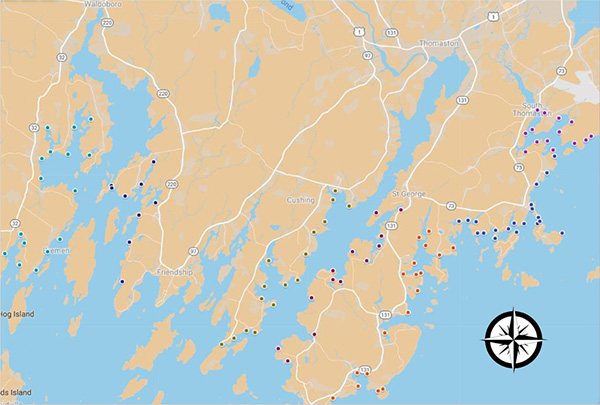
Water Sampling sites are divided up into "runs", or groups of stations, that can be collected efficiently within six hours around high tide. During the 2019 field season seven additional runs were successfully completed by boat that resulted in 109 additional stations being collected by boat this year. In the Medomak and St. George rivers, individual land runs along the east and west shorelines were able to be combined into a single boat run making the collection of those runs faster and more efficient when collected by boat.
Collecting water samples by boat has several advantages. Sample sites can be positioned and collected in locations that potentially better represent the water body that they are intended to monitor. Sampling by boat also allows for a much better opportunity to inspect the entire waterbody and shoreline of an area for potential pollution when transiting between sites. Roads tend to be located at least a couple hundred feet inland and this limits the ability to see large portions of the shoreline when collecting samples by land. In most cases, boat sampling runs can also be completed in less time. Rivers, especially, can be sampled more quickly as it's usually quick and easy to zig-zag up or down a river in a boat. Whereas accessing river stations by vehicle often involves long, windy dirt roads and long walks to shoreline access points.
The challenges related to boat sampling are mostly related to safety and boat operator experience. Maine has large tidal ranges, remote shorelines with limited and often difficult access, unmarked marine hazards and open ocean-like conditions at the end of exposed, rocky peninsulas. Many sample sites are located up tidal creeks and over mud flats where the water is only deep enough for a boat a few hours a day. Taking this into account is critical to make sure that the boat will make it back out of an area after it enters. In addition to on the water challenges, boat launches are sometimes small or at the end of windy roads making trailering and launching a bigger challenge as well. it's also more difficult to find and train personnel who are competent trailering and launching boats, as well as safely operating them, along the remote, rugged coast of Maine.
These challenges are certainly worth addressing and overcoming so that the DMR Water Quality Program can maintain a safe and professional boating program. Through training, mentoring and lots of practice we have been able to develop a team of boat operators and crew that can safely conduct boat operations all along the coast. As long as resources continue to be available and staff are enthusiastic about boat operations, then the Water Quality Program should be able to continue to build and solidify a safe, effective boating program.
The Importance of Proper Shellfish Tags
By Kohl Kanwit, Public Health Bureau Director
Tagging shellfish is one of the most vital elements of the shellfish sanitation program because it allows public health professionals to identify a harvest area potentially associated with an illness outbreak. Maine fortunately does not have a history of shellfish related illness outbreaks but maintaining vigilance and following the requirements of the National Shellfish Sanitation Program (NSSP) is critically important. The requirements for both harvester and dealer tags are defined in the NSSP model ordinance and sample tags with the minimum amount of information included are pictured below.
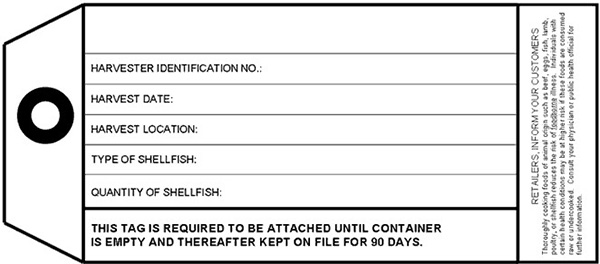
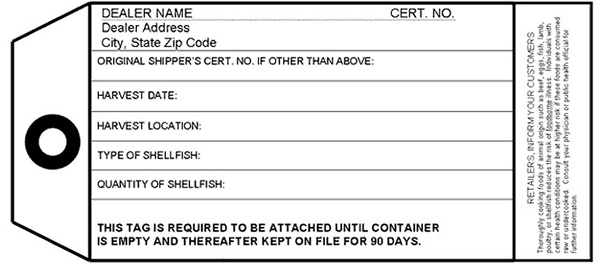
Recently a US Food and Drug evaluation in another state turned up an incomplete tag from shellfish harvested in Maine. Two important discrepancies were noted, can you find them in the picture below? Hint, it isn't the dealer name, address and certification number - those were blacked out for privacy purposes.
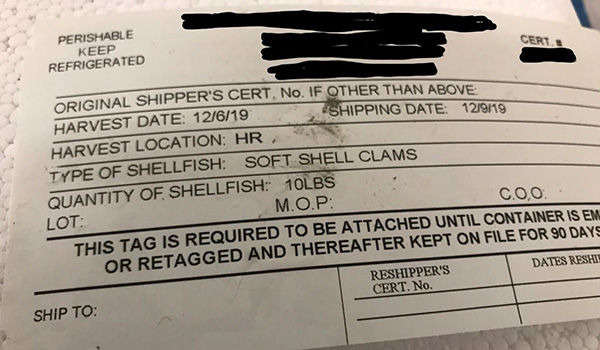
First, the harvest area:
The NSSP requires in Chapter X .05 B.(2)(f): The most precise identification of the harvest location as is practicable including the initials of the State of harvest, and the Authority's designation of the growing area by indexing, administrative or geographic designation. If the Authority has not indexed growing areas, then an appropriated geographical or administrative designation must be used (e.g., Long Bay, Decadent County, lease number, bed, or lot number).
In this example, harvest area is listed as "HR" and does not include a state designation. The proper harvest area notation would be "Harraseeket River, Freeport ME". Please note that if there were an illness outbreak associated with this shellstock, DMR would be forced to close a large area (e.g. all of Freeport or Casco Bay) due to the lack of specificity indicated by the tag. In this case, less is not more!
Second, the required statement at the bottom of the tag has not been updated to reflect new requirements implemented in 2017.
THIS TAG IS REQUIRED TO BE ATTACHED UNTIL CONTAINER IS EMPTY OR IS RETAGGED AND THEREAFTER KEPT ON FILE, IN CHRONOLOGICAL ORDER, FOR 90 DAYS. RETAILERS: DATE WHEN LAST SHELLFISH FROM THIS CONTAINER SOLD OR SERVED (INSERT DATE) .
Please review your tags and ensure they meet NSSP requirements. If you have questions, feel free to contact us here at DMR.
Walkover Surveys - A Qualitative Overview of Shellfish
By Heidi Leighton, DMR Scientist
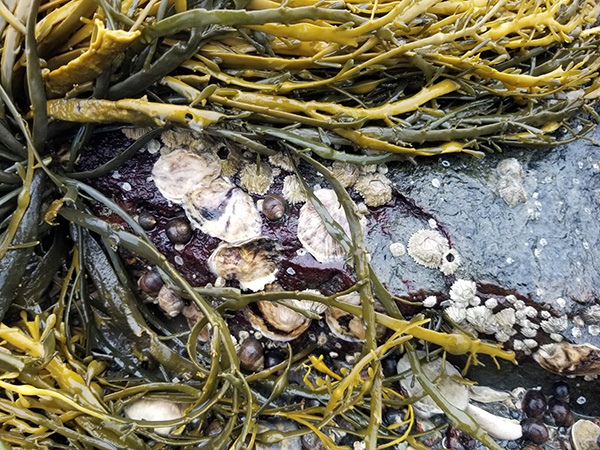
Assessing intertidal shellfish resources over the entire coast of Maine is a daunting task for the four person Shellfish Management Program. One tool that our biologists use is the intertidal walkover survey which is designed to provide a qualitative overview of the overall status of a cove or flat. Walkover surveys are a snapshot in time which give us information on the relative abundance of commercially important shellfish species and shellfish predators, harvesting activity, and general habitat characteristics.
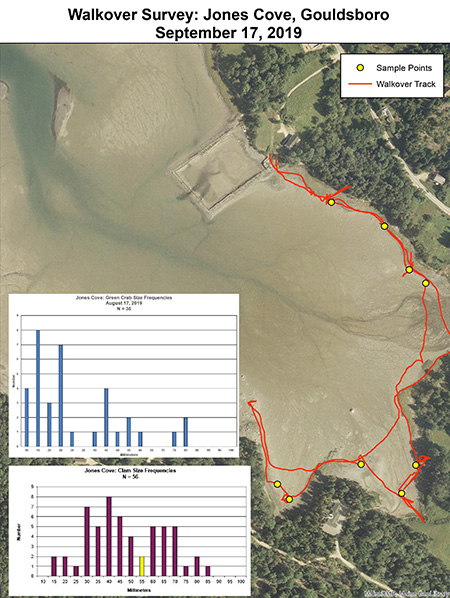
Walkover surveys are different from traditional clam population surveys. Population surveys are quantitative. The method involves removing, counting and measuring the length of all clams from small representative sample plots and then using the data to estimate the abundance and the size distribution of all clams in the surveyed area. It is much more labor intensive and time consuming. Population surveys do not provide information about anything other than the species you are surveying for.
In contrast, walkover surveys require fewer staff and much more area can be covered. Walkovers provide information as to where on a flat shellfish are located, what the general sizes of those shellfish are, the type and abundance of predators, and other potential issues that might impact the health of shellfish like algal blooms. All commercially important shellfish species are noted, and their abundance estimated.
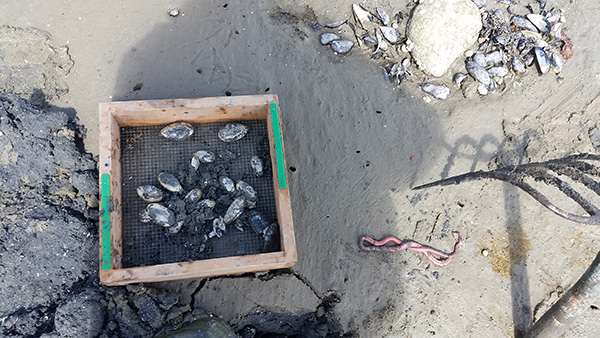
Our aim with the walkover surveys is to provide a consistent methodology over time which allows us to observe trends in resource levels. We hope that our information will be useful to municipalities as they manage their shellfish programs. Our use of walkover surveys will continue to expand, balancing efforts between areas known to be commercially productive with areas with little to no past data.
Shout Out to 2019 Biotoxin and Water Quality Volunteers
By Amy Webb - DMR Public Health Laboratory Tech
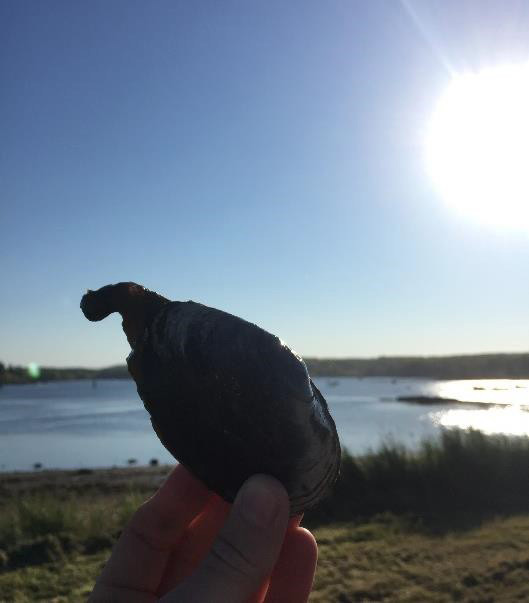
The Department of Marine Resources (DMR), Bureau of Public Health protects public health by monitoring coastal water quality and toxic phytoplankton in all shellfish harvesting areas. In order to monitor the water quality and phytoplankton community along the entire coast of Maine, the DMR relies on trained volunteers to assist with seawater collection and phytoplankton identification. Water quality volunteers assist DMR staff throughout the year by collecting water samples for analysis of fecal coliforms at our labs in Lamoine and Boothbay Harbor. Phytoplankton volunteers collect water samples, filter and identify toxic phytoplankton species in the spring, summer, and fall. The identification of toxic phytoplankton provides an early warning system for the
accumulation of biotoxins in shellfish tissue.
In 2019 we had 81 water quality and phytoplankton volunteers collect samples along the Maine coastline from Kennebunkport all the way to Machiasport. As of early December, water quality volunteers collected an estimated 1,630 water samples. Phytoplankton volunteers collected, identified and enumerated phytoplankton in over 140 samples from
22 different sites across the state. The results from the phytoplankton samples are used immediately to determine where to test shellfish for toxicity. The results from the water quality samples (along with past years' data) will be used to assist the department to determine when and where next year's shellfish can be harvested and sold for human consumption.
The entire DMR Bureau of Public Health staff would like to send out a big thank you to our volunteers for their hard work this past year. We look forward to working with you in 2020.